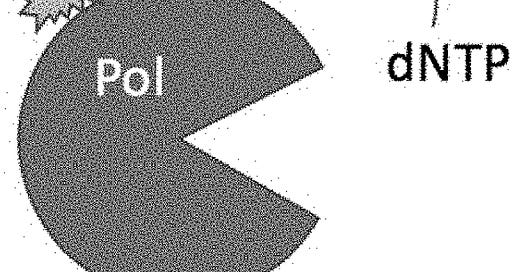Element Biosciences - Chemistry
UPDATE: Over on twitter, Simon Barnett pointed me toward this patent, which describes a related approach. Most of the conclusions in this post hold, but I’m be posting another post on this, and other aspects of the Element platform soon.
Over at OmicsOimcs, Keith mentioned that “each position is probed twice, once with labels and the polymerase unable to extend and once with unlabeled reversible terminators”. This “two-step” approach isn’t unique to Element, Omniome for example, have proposed a process where the binding and incorporation events are independent.
In any case, I was interested in digging into the Element IP a bit further to see if I could figure out exactly what they were doing. One patent, discusses “Polymerase-nucleotide conjugates for sequencing by trapping” and looks particularly promising.
The figure below describes the basic workflow, where a labeled polymerase with a conjugated nucleotide (essentially tethered) binds to a strand under synthesis. The polymerase is labeled (fluorescently). Post-imaging this conjugate is removed, and regular reversible terminators are incorporated, to move the strand on to the next position (as with strandard sequencing-by-synthesis):
Critically, the nucleotide conjugated polymerase does not incorporate the nucleotide. The patent suggests a number of ways of preventing incorporation, for example “a point mutation that allows binding but block catalysis” or “reaction conditions comprising the use of a non-catalytic divalent metal cofactor or removing a required catalytic metal co-factor”.
This nucleotide-polymerase conjugate approach is neat, but not entirely novel, Ansa Bio have been developing this approach for enzymatic DNA synthesis for some time.
Element appear to be suggesting that this approach will lower error rates, presumably because your unlabeled nucleotides incorporate more easily. It’s odd that this doesn't seem to result in longer reads however.
I also imagine that the approach requires an additional wash cycle (not shown in the diagram above) to remove free nucleotides before the block is removed (though potentially there are ways to do this without a wash).
The approach is pretty neat, and it’s always impressive to me that you can attach a (relatively tiny) nucleotide to a polymerase and have it incorporate.
Below the paywall break below, I discuss how I imagine this might play out in a little more detail…




